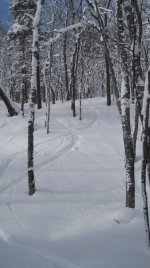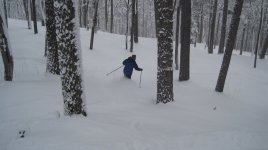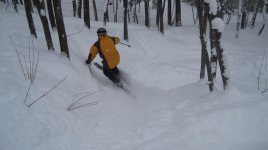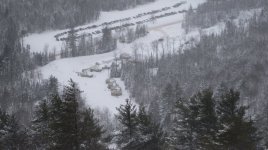Excellent points by both Riverc0il and EMSC. Vail I view like Whistler. It has the natural attributes of terrain and snow plus the other stuff, and is a very valuable property IMHO even with no growth or additional real estate.
Soulskier is not going to find anyplace where he can implement that entire laundry list. Just as the resort model didn't find some mid-size areas like Tamarack that attempted to clone it, there aren't that many locations which will fit the MRA model either. I would caution soulskier to view any prospective area within its regional context, which Tamarack and The Canyons clearly did not. I would also suggest that soulskier spend the upcoming ski season actually visiting some of the "small but interesting places," assess how viable they are and how many of the attributes on that list apply to them. I would suggest Castle Mt. and Whitewater in Canada, Powder Mt. in Utah, and some of those Montana areas q visits every year.
* A well-laid-out, strategically placed lift system
MRA-type areas almost by definition have slow lifts with some grunt work required to reach some of the goods. I would think in this model one would be very sparing in spending big $ on new lifts. You should be buying old chairs from areas putting in high speeds, even surface lifts, to serve terrain expansions.
* Free parking that offers quick access to the lifts
Agree, but you might inherit awkwardly situated parking
* Lodge floor plans that keep walking in boots in mind, as well as comfortable seating for everyone
See lift issue above. Spending big $ on shiny new lodges is probably something you should avoid. You probably want to live with the one you inherit, making incremental improvements.
* Avoiding profit margins based solely on skier visits
Since we're avoiding real estate plays and frou-frou amenities, what else would profit margins be based upon?
* Staying open until the snow runs out
Actually they do that here in SoCal, even at minimalist places like Baldy. But we have a big population base (without cold winters) to support that. Out in big snow country the locals are snow snobs and eager to move on to summer pursuits when the weather warms up.
* Base area lodges that offer healthy, cost-efficient food, are brown bag lunch supportive, and filled with fun off-the-slopes activities for those not interested in being on the hill
Agree, though the latter needs to be kept simple and inexpensive.
* A reliable shuttle bus that runs at opportune times for riders
Not sure whether we're talking about places with awkward parking or town-to-mountain shuttles. It depends on the specific situation.
* Treating all guests with respect, kindness and appreciation
That's not so easy with transient employees and erratic seasons, as I see at Baldy (another place soulskier should probably visit).
* A clock and trail updates at all lift stations
The boards like Alta's would be good. The big electronic signs like Vail or Big Bear are an unnecessary expense.
* Hydration stations located in strategic areas
I wouldn't spend $ to run plumbing where it isn't already.
* An updated, real-time website that provides information about lift operations, including weather conditions, accurate wind speeds and direction, hourly temperatures, rate of snowfall and water content, operating lifts and reason for closures, current avalanche forecast, and an interactive message board to speak your mind
This is the direction I've been advocating for Mt. Baldy. Very cost effective in improving local image and user friendly reputation.
* Low-interest and affordable payment plans for passes
This has to be a fairly hard headed economic decision. The relationship between day and season pass pricing is all over the map, varying by area and region.
* The ability to purchase investment shares, and become an owner in your own ski-energy center
* Shareholder and member privileges
This was the issue discussed at some length with Shames. MRG is the model here. This is the ski area soulskier really needs to visit and study. Hopefully he will come away with a different view than he expressed during the Shames episode.
Soulskier is not going to find anyplace where he can implement that entire laundry list. Just as the resort model didn't find some mid-size areas like Tamarack that attempted to clone it, there aren't that many locations which will fit the MRA model either. I would caution soulskier to view any prospective area within its regional context, which Tamarack and The Canyons clearly did not. I would also suggest that soulskier spend the upcoming ski season actually visiting some of the "small but interesting places," assess how viable they are and how many of the attributes on that list apply to them. I would suggest Castle Mt. and Whitewater in Canada, Powder Mt. in Utah, and some of those Montana areas q visits every year.
* A well-laid-out, strategically placed lift system
MRA-type areas almost by definition have slow lifts with some grunt work required to reach some of the goods. I would think in this model one would be very sparing in spending big $ on new lifts. You should be buying old chairs from areas putting in high speeds, even surface lifts, to serve terrain expansions.
* Free parking that offers quick access to the lifts
Agree, but you might inherit awkwardly situated parking
* Lodge floor plans that keep walking in boots in mind, as well as comfortable seating for everyone
See lift issue above. Spending big $ on shiny new lodges is probably something you should avoid. You probably want to live with the one you inherit, making incremental improvements.
* Avoiding profit margins based solely on skier visits
Since we're avoiding real estate plays and frou-frou amenities, what else would profit margins be based upon?
* Staying open until the snow runs out
Actually they do that here in SoCal, even at minimalist places like Baldy. But we have a big population base (without cold winters) to support that. Out in big snow country the locals are snow snobs and eager to move on to summer pursuits when the weather warms up.
* Base area lodges that offer healthy, cost-efficient food, are brown bag lunch supportive, and filled with fun off-the-slopes activities for those not interested in being on the hill
Agree, though the latter needs to be kept simple and inexpensive.
* A reliable shuttle bus that runs at opportune times for riders
Not sure whether we're talking about places with awkward parking or town-to-mountain shuttles. It depends on the specific situation.
* Treating all guests with respect, kindness and appreciation
That's not so easy with transient employees and erratic seasons, as I see at Baldy (another place soulskier should probably visit).
* A clock and trail updates at all lift stations
The boards like Alta's would be good. The big electronic signs like Vail or Big Bear are an unnecessary expense.
* Hydration stations located in strategic areas
I wouldn't spend $ to run plumbing where it isn't already.
* An updated, real-time website that provides information about lift operations, including weather conditions, accurate wind speeds and direction, hourly temperatures, rate of snowfall and water content, operating lifts and reason for closures, current avalanche forecast, and an interactive message board to speak your mind
This is the direction I've been advocating for Mt. Baldy. Very cost effective in improving local image and user friendly reputation.
* Low-interest and affordable payment plans for passes
This has to be a fairly hard headed economic decision. The relationship between day and season pass pricing is all over the map, varying by area and region.
* The ability to purchase investment shares, and become an owner in your own ski-energy center
* Shareholder and member privileges
This was the issue discussed at some length with Shames. MRG is the model here. This is the ski area soulskier really needs to visit and study. Hopefully he will come away with a different view than he expressed during the Shames episode.






